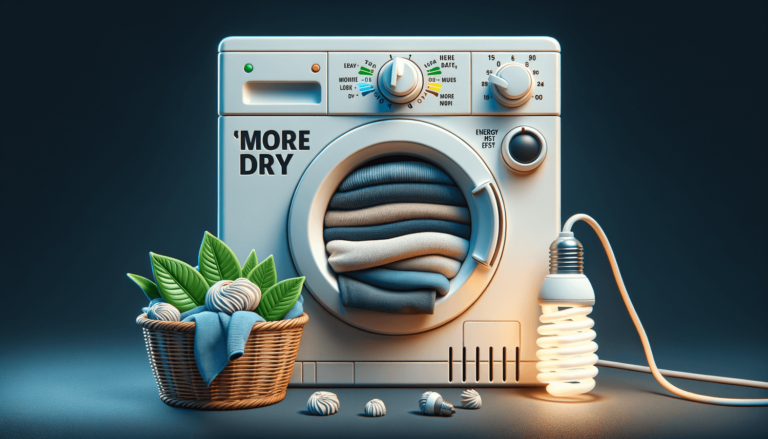

‘More Dry’ on a dryer refers to a setting that extends the drying time, ensuring clothes come out with minimal moisture, suitable for thicker fabrics or garments that need extra drying time.
Have you ever found yourself staring at your dryer’s control panel, puzzled by options like ‘More Dry,’ ‘Less Dry,’ or ‘Optimal Dry’? You’re not alone. These settings often confuse many people, so we’ve created this guide to explain these terms. So, let’s start with the most asked question: “What does ‘More Dry’ mean on a dryer?”
If you’ve selected the ‘More Dry’ setting on your dryer, you’re choosing a cycle that will continue until the moisture sensors inside the machine detect very low moisture levels. In simple terms, the ‘More Dry’ setting aims to get your clothes as dry as possible, minimizing any remaining dampness.
The ‘More Dry’ setting on a dryer is especially useful for thicker fabrics and garments, like jeans or sweatshirts, that take longer to dry. Using this setting ensures that these clothes are completely dry and not just surface-dry.
So, what is ‘More Dry’ on a dryer actually good for? This setting is ideal when you’re in a hurry and need your clothes to be as dry as possible for immediate use or storage. It’s also handy for fabrics that tend to retain more moisture.
Understanding the difference between ‘More Dry’ vs ‘Less Dry’ is crucial for effective laundry. ‘More Dry’ aims to remove as much moisture as possible, while ‘Less Dry’ leaves a bit of moisture in your clothes, making them easier to iron. However, the ‘Less Dry’ option is unsuitable for clothes you intend to store immediately, as they might develop a musty smell.
You might wonder, “What does dryness mean on a dryer?” Dryness in this context refers to how much moisture is left in your clothes post-cycle. Higher dryness levels mean the clothes are ready for immediate storage, while lower levels are ideal for clothes you plan to iron.
When it comes to understanding what ‘More Dry’ and ‘Less Dry’ mean, it’s all about the moisture level in your clothes after the drying cycle. ‘More Dry’ ensures that clothes are dry enough to be stored away immediately. ‘Less Dry,’ on the other hand, leaves a slight amount of moisture, which is often preferred when you plan to iron your clothes.
Optimum Dry in a dryer is an automatic feature that detects when clothes reach their ideal dryness. It prevents over-drying and under-drying, using sensors to adjust cycle duration, ensuring energy efficiency and optimal garment care.
Less Dry on a dryer indicates a setting where clothes are dried only to a slight dampness, ideal for items that may shrink or for those preferring a shorter drying time. This option uses sensors to stop the cycle before clothes are fully dry.
“Dry” refers to the absence of moisture or wetness in an object or environment. It can describe a condition where something is free from liquid or has had all liquid removed.
The ‘More Dry’ option is one of the many dryer settings available to help achieve the perfect level of dryness for your clothes. Dryers often have various settings to accommodate diverse fabric types and drying requirements.
Most dryers have settings like ‘Normal Dry’, ‘Less Dry’, ‘More Dry’, and ‘Timed Dry’, which offer different levels of drying time. A dryer equipped with moisture sensors, like those often reviewed on Settings King, can automatically adjust the drying time to prevent over-drying your clothes.
To effectively use the ‘More Dry’ setting, reserve it for thick fabrics or garments that require more thorough drying. For lighter and delicate clothes, use the ‘Normal’ or ‘Less Dry’ settings, which are more energy-efficient and gentler on the fabrics. Be sure to consult your dryer’s user manual and the articles on Settings King, a blog about technology settings, to ensure best practices for your specific appliance.
If you’ve ever been puzzled by your dryer’s settings and wondered about the ‘More Dry’ option, you’re not alone. In this blog post, we will explore the nuances of ‘More Dry’ and how to use it effectively to achieve perfectly dried clothes. As always, Settings King is here to help you navigate the often perplexing world of technology settings.
The ‘More Dry’ option is one of many dryer settings designed to cater to different fabric types and drying needs. Dryers often have settings like ‘Normal Dry’, ‘Less Dry’, ‘More Dry’, and ‘Timed Dry’, each designed to provide varying levels of drying time. Dryers with moisture sensors can also automatically adjust the drying time to prevent over-drying your garments, as we’ve discussed in our previous Settings King articles.
While ‘More Dry’ is useful for thick or bulky fabrics, most dryers have settings that accommodate lighter and delicate clothes. ‘Normal Dry’ or ‘Less Dry’ options offer shorter drying times, which are more energy-efficient and can prevent excessive wear on your garments. Consult your dryer’s user manual and the articles on Settings King, a blog about technology settings, to determine best practices for your particular appliance.
To use the ‘More Dry’ setting effectively, reserve it for garments which require longer drying times, such as heavy towels, jeans, and thick fabrics. Refrain from using this setting for lighter, more delicate clothes which might suffer from over-drying.
Understanding dryer settings is essential in achieving perfectly dried clothes, and a few additional tips can take it a step further. Consider the following tips recommended by Settings King:
After reading this article on dryer settings, you might have additional questions about using the ‘More Dry’ option effectively. For your convenience, we’ve compiled a list of frequently asked questions that are directly related to this blog post. Let Settings King help you with your laundry duties.
Use the ‘More Dry’ setting for thick, bulky fabrics or garments, such as heavy towels, jeans, comforters, and bedding. This setting ensures these items get dried thoroughly without over-drying lighter clothes that may be in the load.
Opt for the ‘Normal Dry’ or ‘Less Dry’ setting for energy efficiency. These settings offer shorter drying times and are ideal for lighter, more delicate clothes. A dryer with moisture-sensing capabilities can provide additional energy savings by adjusting the drying time based on the moisture content of your clothes.
It’s best to separate your garments by fabric type and weight before drying. This practice ensures even and efficient drying, as well as prevents potential damage to delicate clothes that might suffer from over-drying if mixed with heavy fabrics.
Use appropriate dryer settings, like ‘Normal Dry’ or ‘Less Dry’, for lighter clothes. Also, consider separating your garments by fabric type and investing in a dryer with moisture-sensing capabilities to help prevent over-drying and preserve your clothes’ quality.
Yes, cleaning the lint filter after each load is essential for maintaining your dryer’s performance and safety. Regularly clearing out lint helps improve air circulation, promotes energy efficiency and decreases the risk of potential fire hazards.